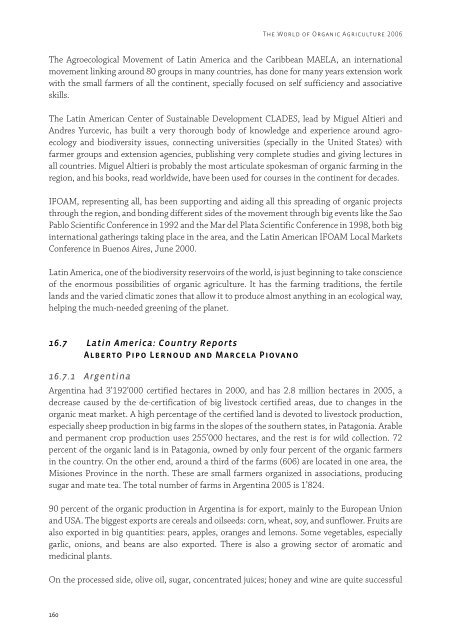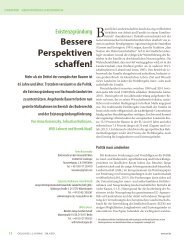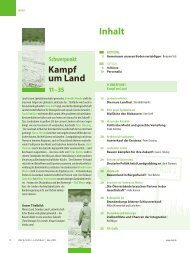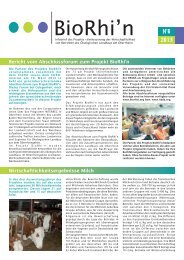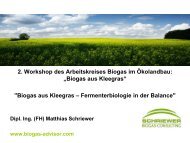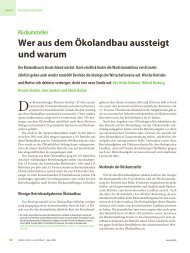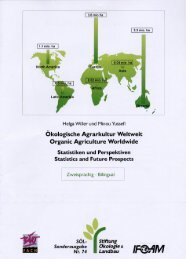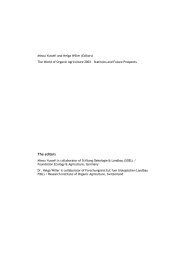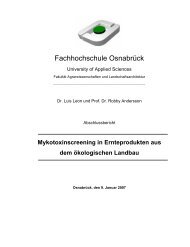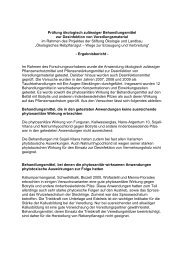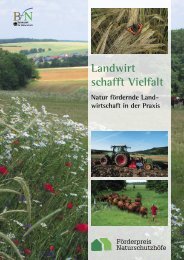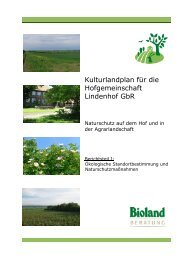the world of organic agriculture - Organic Eprints
the world of organic agriculture - Organic Eprints
the world of organic agriculture - Organic Eprints
Create successful ePaper yourself
Turn your PDF publications into a flip-book with our unique Google optimized e-Paper software.
160<br />
The World <strong>of</strong> <strong>Organic</strong> Agriculture 2006<br />
The Agroecological Movement <strong>of</strong> Latin America and <strong>the</strong> Caribbean MAELA, an international<br />
movement linking around 80 groups in many countries, has done for many years extension work<br />
with <strong>the</strong> small farmers <strong>of</strong> all <strong>the</strong> continent, specially focused on self sufficiency and associative<br />
skills.<br />
The Latin American Center <strong>of</strong> Sustainable Development CLADES, lead by Miguel Altieri and<br />
Andres Yurcevic, has built a very thorough body <strong>of</strong> knowledge and experience around agroecology<br />
and biodiversity issues, connecting universities (specially in <strong>the</strong> United States) with<br />
farmer groups and extension agencies, publishing very complete studies and giving lectures in<br />
all countries. Miguel Altieri is probably <strong>the</strong> most articulate spokesman <strong>of</strong> <strong>organic</strong> farming in <strong>the</strong><br />
region, and his books, read <strong>world</strong>wide, have been used for courses in <strong>the</strong> continent for decades.<br />
IFOAM, representing all, has been supporting and aiding all this spreading <strong>of</strong> <strong>organic</strong> projects<br />
through <strong>the</strong> region, and bonding different sides <strong>of</strong> <strong>the</strong> movement through big events like <strong>the</strong> Sao<br />
Pablo Scientific Conference in 1992 and <strong>the</strong> Mar del Plata Scientific Conference in 1998, both big<br />
international ga<strong>the</strong>rings taking place in <strong>the</strong> area, and <strong>the</strong> Latin American IFOAM Local Markets<br />
Conference in Buenos Aires, June 2000.<br />
Latin America, one <strong>of</strong> <strong>the</strong> biodiversity reservoirs <strong>of</strong> <strong>the</strong> <strong>world</strong>, is just beginning to take conscience<br />
<strong>of</strong> <strong>the</strong> enormous possibilities <strong>of</strong> <strong>organic</strong> <strong>agriculture</strong>. It has <strong>the</strong> farming traditions, <strong>the</strong> fertile<br />
lands and <strong>the</strong> varied climatic zones that allow it to produce almost anything in an ecological way,<br />
helping <strong>the</strong> much-needed greening <strong>of</strong> <strong>the</strong> planet.<br />
16.7 Latin America: Country Reports<br />
Alberto Pipo Lernoud and Marcela Piovano<br />
16.7.1 Argentina<br />
Argentina had 3’192’000 certified hectares in 2000, and has 2.8 million hectares in 2005, a<br />
decrease caused by <strong>the</strong> de-certification <strong>of</strong> big livestock certified areas, due to changes in <strong>the</strong><br />
<strong>organic</strong> meat market. A high percentage <strong>of</strong> <strong>the</strong> certified land is devoted to livestock production,<br />
especially sheep production in big farms in <strong>the</strong> slopes <strong>of</strong> <strong>the</strong> sou<strong>the</strong>rn states, in Patagonia. Arable<br />
and permanent crop production uses 255’000 hectares, and <strong>the</strong> rest is for wild collection. 72<br />
percent <strong>of</strong> <strong>the</strong> <strong>organic</strong> land is in Patagonia, owned by only four percent <strong>of</strong> <strong>the</strong> <strong>organic</strong> farmers<br />
in <strong>the</strong> country. On <strong>the</strong> o<strong>the</strong>r end, around a third <strong>of</strong> <strong>the</strong> farms (606) are located in one area, <strong>the</strong><br />
Misiones Province in <strong>the</strong> north. These are small farmers organized in associations, producing<br />
sugar and mate tea. The total number <strong>of</strong> farms in Argentina 2005 is 1’824.<br />
90 percent <strong>of</strong> <strong>the</strong> <strong>organic</strong> production in Argentina is for export, mainly to <strong>the</strong> European Union<br />
and USA. The biggest exports are cereals and oilseeds: corn, wheat, soy, and sunflower. Fruits are<br />
also exported in big quantities: pears, apples, oranges and lemons. Some vegetables, especially<br />
garlic, onions, and beans are also exported. There is also a growing sector <strong>of</strong> aromatic and<br />
medicinal plants.<br />
On <strong>the</strong> processed side, olive oil, sugar, concentrated juices; honey and wine are quite successful


